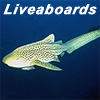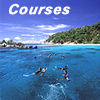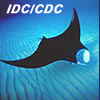Reef Ecology Guide Phuket Thailand - Bony Fishes 3
TRIGGERFISHES (Balistidae)

A moderately large family, common to our area and often encountered around the Similan Islands. Large-headed fishes, first dorsal fin with 3 spines, of which the first is stout and lockable in upright position by second spine. Pectoral fin usually small and paddle-like. Their jaws are very strong, each with 8 long close-set teeth.
Most species are distinctly colored and readily identified. In most species there is virtually no difference between sexes. Males of some species are known to make nests and guard eggs vigorously, often attacking divers which venture into their territory.
To escape danger, trigger fishes use narrow holes or ledges in which they wedge themselves head inwards, with the trigger dorsal spine locked in upright position, making it very difficult to be pulled out. Diet comprises of hard-shelled molluscs and echinoderms.
GIANT TRIGGERFISH (Balistoides viridescens)
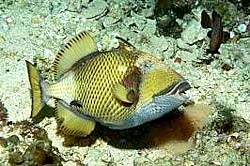 Length: to 80 cm
Length: to 80 cm
The largest triggerfish and one which can be very aggressive when guarding nests but may attack divers for no obvious reason.
Best to swim around large individuals at distance, rather than crossing its area. Usually seen singly on costal slopes near to deep water.
FILEFISHES (Monacanthidae)

A large family of small to medium sized fishes. Most species change in shape with age, juveniles may be almost circular and very compressed, whilst adults are very elongate.
The body is covered by tiny prickly scales, forming a tough leathery or velvet-like skin. A prominent and separate first dorsal fin spine is an obvious feature in most species. In nearly all species the spine is lockable in an upright position.
Most of the reef species are distinctly colored or shaped and identification usually is easy. Most are greenish and a great number of species associate with weeds or sea grasses in which they camouflage.
PUFFERFISHES (Tetraodontidae)

Their common name applies to their ability to inflate themselves to almost balloon proportions to deter predators. In addition many species are prickly when inflated and become even more hazardous to consume. All species are poisonous in either internal organs or skin toxins, giving a clear message: leave me alone. With some species diet includes almost everything whilst others have preferences for certain invertebrates or algae, but all seem to consume a great variety.
Closely related to the puffer fishes are the PORCUPINEFISHES (Diodontidae). They are similar in their ability to inflate themselves to considerable size, but have in addition large spines which point outwards when inflated. Their teeth are totally fused into beaklike jaws.
Also closely related to puffer fishes are the BOXFISHES (Ostraciidae). The body is largely covered with well defined hexagonal bony plates, fused into a ridged case with holes for the moving parts, the fins, mouth, eyes and gills. The surface of box fishes is smooth but some have prominent spines above eyes or back. The body is covered with toxic mucus, which deter predators but also the toxin is released when under stress, killing other fishes or themselves if kept confined.
BLACKSPOTTED PUFFERFISH (Arothron nigropunctatus)
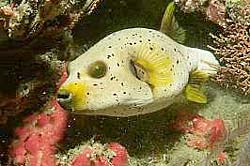 Length: to 30 cm
Length: to 30 cm
This species mainly lives on coral reefs, often sleeping in barrel sponges.
Highly variable, gray to brown or bright yellow, black spotted to various degrees. Occurs singly or in pairs.
STARRY PUFFER (Arothron stellatus)
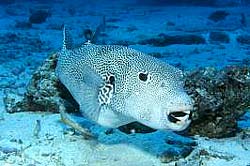 Length: to 1,2 m
Length: to 1,2 m
Largest of all puffer fishes, encountered to 60 m. Prefers reefs with caves and large sponges, usually seen singly.
Feeds on invertebrates, mainly echinoderms.
COMMON PORCUPINEFISH (Diodon hystrix)
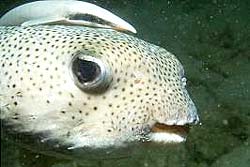 Length: to 70 cm
Length: to 70 cm
This species inhabits coral or rocky reefs, usually seen singly, often swimming high above the substrate during the day.
Feeds on invertebrates, mainly shells and molluscs.
ANGLERFISHES (Antennariidae)

This family is unique in having a peculiar luring apparatus above the mouth, usually a modified first dorsal spine, which is specialized in each species by mimicking the food-source of its prey. So the potential victim sees its favorite food, which in reality is a copy in looks and motion. What appears as an easy meal, lures the victim closer where it becomes a meal itself.
Anglerfishes don't just position themselves anywhere, but choose a spot where prey is likely to come along. The tropical species primarily feed on other fishes and with their expandable stomach can accommodate any large prey which passes through the mouth.
PAINTED ANGLERFISH (Antennarius pictus)
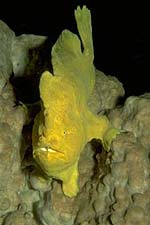 Length: to 24 cm
Length: to 24 cm
A very common but one of the most variable species, virtually appearing in all colors but blue and green, matching most sponge colors.
Inhabits coastal reefs, lagoons and slopes with corals, sponges or at night just out in the open on sand. We see them often in the Similan Islands and around Phi Phi Island.
LIZARDFISHES (Synodontidae)

A primarily tropical family, comprising about 40 species worldwide. Most are reef predators, featuring a torpedo shaped body, a large mouth with long needle-like teeth along entire jaws to seize prey.
On tropical reefs they rest on top of reefs, strategically chosen, to view the area for possible prey. Camouflaged and waiting motionless in ambush, with lightning speed a careless fish is taken. Usual prey is juveniles of larger reef dwellers. Most species are found near reefs on sand, reef crests or rubble slopes, sometimes burying in the substrate.
Dive Asia - Phuket Thailand
Office Address: 23/6 Karon Rd, Kata Beach, Phuket 83100, Thailand
Phone: +66 (0) 76330598
Visit us at one of our Offices: (Google Map)
Email:
Website: www.diveasia.com
24 Hour Hotline: +66 (0) 818948588








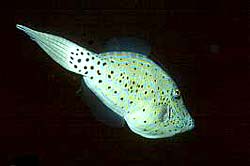 Length: to 1 m
Length: to 1 m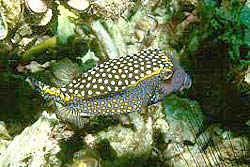 Length: to 16 cm
Length: to 16 cm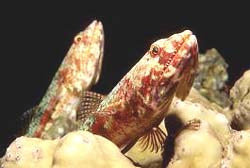 Length: to 25 cm
Length: to 25 cm